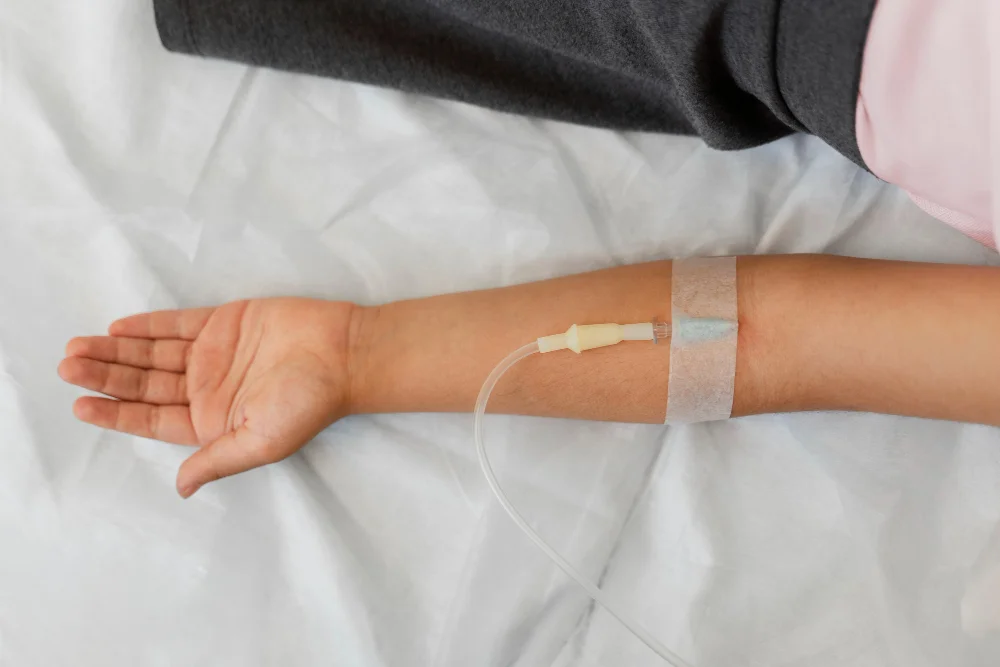IV therapy has moved outside hospital settings. Wellness clinics, mobile services, and fitness centers now offer these treatments. Athletes get them after workouts. Business travelers use them for jet lag. People try them for hangover relief.
This expansion raises questions about safety. Hospitals follow strict rules and oversight. Wellness businesses sometimes operate with different standards. Understanding what is iv solution becomes important before trying any treatment.
IV therapy puts substances directly into your bloodstream, bypassing your stomach and intestines. This works fast but also means problems can happen quickly. Contamination or wrong ingredients can cause immediate harm. You need to know what goes into your body, what can go wrong, and how to find safe providers.
What Is IV Solution: Understanding the Basics
Definition and Key Components
What is iv solution? It's sterile liquid put directly into your veins through a small tube and needle. Medical-grade versions contain measured amounts of specific ingredients for treatment purposes.
The base is usually sterile water or salt water. Doctors add minerals like sodium, potassium, and magnesium. Based on what they're treating, they might add vitamins, medications, or nutrients.
Quality matters with IV preparations. Medical-grade ingredients get tested for purity and germs. The mixing must follow strict rules to prevent contamination. Small amounts of dirt or bacteria can cause bad reactions when injected straight into blood.
How much of each ingredient and what combinations are used determines effects on your body. Wrong amounts of minerals can mess up normal body functions. This is why proper medical supervision matters for safe use.
Types of IV Solutions
Three main types exist based on their concentration compared to blood:
Isotonic solutions match blood concentration. Regular salt water is the common example. These stay in blood and increase blood volume without making cells swell or shrink.
Hypotonic solutions have less concentration than blood. They move from blood vessels into cells, helping hydrate cells from inside. These need careful use to avoid too much cell swelling.
Hypertonic solutions have more concentration than blood. They pull water from cells into blood vessels. Doctors use these for specific problems but watch patients closely during treatment.
Medical and Wellness Uses
Hospitals use iv solutions for critical care. Emergency rooms give fluids to trauma patients who lost blood. Surgery teams use them during and after operations. Hospitals use them to give medications and keep patients hydrated when sick.
Wellness uses have grown recently. Sports recovery places offer hydration after hard training. Some places provide vitamin treatments claiming to boost immunity or energy. Hangover clinics give hydration and vitamins after drinking alcohol.
Medical versus wellness use matters for safety. Medical treatment happens with strict oversight and trained staff watching for problems. Wellness treatments sometimes have looser standards, making your choice of provider crucial.
Benefits of IV Solutions
Rapid Rehydration
Dehydration hurts the body fast. From sickness, exercise, or not drinking enough, it causes tiredness, dizziness, confusion, and in bad cases, organ damage. An iv solution for dehydration gives the fastest rehydration available.
IV fluids go straight into blood, skipping digestion. Your body doesn't process or absorb them. Within minutes, blood volume goes up and cells get the water they need.
Compare this to drinking water or sports drinks. Drinking requires your gut to absorb fluids, which takes time. If you're throwing up or have bad diarrhea, drinking might not work.
Athletes in long competitions sometimes get IV hydration between event days. Emergency rooms use it for heat stroke. Some travelers use it to recover from bad dehydration faster than just drinking would allow.
Medical Applications
Hospitals use IV solutions for serious situations:
- Trauma victims need fast fluid replacement to keep blood pressure and organs working
- Surgery patients get fluids during operations and recovery for hydration and medications
- Cancer patients often need IV hydration because treatment causes bad nausea and vomiting
- Patients who can't eat or drink depend on IV nutrition to survive
Emergency medicine depends on IV access. Heart attack patients get drugs through IVs. Stroke victims get urgent treatments through veins. Bad allergic reactions need immediate IV epinephrine.
Wellness and Recovery Uses
Sports recovery places claim IV fluids help athletes recover faster from hard training or competition. Fast hydration and mineral replacement might cut recovery time compared to just drinking.
Some places offer high-dose vitamin mixes, though science hasn't proven they work well. People sometimes feel better after these treatments, but placebo effects might explain some results.
Hangover services have started in many cities. These places provide hydration with vitamins and nausea medicine. They do treat dehydration symptoms but don't fix alcohol's other body effects.
Absorption Advantages
Absorption means how much of something reaches your blood. Oral vitamins go through your gut, where stomach acid and absorption limits reduce how much gets in your blood.
IV delivery gets everything into blood. All contents of the bag enter your bloodstream. For some nutrients, this difference matters. Vitamin C pills have limited absorption. IV vitamin C gives much higher blood levels.
This helps most for people with gut problems limiting absorption. Those with bowel disease or past stomach surgery might not absorb oral nutrients well. IV delivery skips these problems.
But better absorption doesn't always give better results. Your body controls many nutrient levels. Extra amounts get filtered by kidneys or stored without giving more benefits.
Safety Risks and Complications
Common Side Effects
Even proper IV therapy can cause minor problems. Injection site reactions happen most often:
- Pain when needle goes in
- Bruising around injection spot lasting days
- Swelling or redness where catheter sits
- Vein irritation causing pain along the vein
These usually go away on their own. Ice and regular pain pills help with discomfort. But worse pain, spreading redness, or warmth at injection site might mean infection needing medical care.
Serious Risks
Bad complications can happen when rules aren't followed. Infections are the biggest worry. Any needle breaking skin lets bacteria in. Poor sterile method, dirty solutions, or unclean equipment can put dangerous bacteria straight into blood.
Blood infections can get bad fast, causing sepsis - a deadly condition. Signs include fever, chills, fast heartbeat, confusion, and low blood pressure. This needs immediate hospital care with antibiotics.
Allergic reactions to ingredients range from mild to severe. Some people react to preservatives or specific ingredients. Bad reactions cause breathing trouble, swelling, and dangerous blood pressure drops.
Mineral imbalances happen when mixes have wrong amounts of minerals. Too much or too little affects heart rhythm, muscle function, and nerve signals. Bad imbalances can cause seizures or heart problems.
Fluid overload happens when fluids go in too fast or in too much amount. This is especially dangerous for people with heart or kidney problems. Extra fluid builds up in lungs, causing breathing trouble and possibly respiratory failure.
Who Should Avoid IV Therapy
Some medical conditions increase risks a lot:
- Heart failure patients can't handle extra fluid well
- Kidney disease patients can't filter extra fluids and minerals properly
- Pregnant women should skip unnecessary treatments
- People taking blood thinners have more bleeding and bruising
Anyone thinking about IV therapy must tell providers about all medications and health problems. Some medicines interact with nutrients commonly added to wellness mixes.
Ensuring Safe IV Therapy
Qualified Provider Credentials
Safe treatment starts with picking qualified providers. In hospitals, licensed nurses or doctors give solutions following set rules. They know sterile methods, spotting problems, and handling emergencies.
Wellness businesses have less standard requirements. Some states need licensed medical workers, others have little oversight. Before getting treatment, check that providers have proper medical licenses and training.
Medical checks should happen before every treatment. Providers should review your health history, current medicines, and conditions that might raise risks. They should ask about allergies and past reactions.
Sterile Environment and Quality Standards
The treatment place shows safety standards. Medical facilities keep strict cleanliness. Staff should wash hands well and wear gloves. All equipment should come from sealed, sterile packages opened while you watch.
Solutions should come from good pharmaceutical suppliers. Ask about ingredient sources and quality testing. Proper mixes have labels showing contents, concentration, expiration dates, and batch numbers.
Watch how staff prepare and give your treatment. They should clean the injection spot with antiseptic and use sterile method throughout. The bag should hang on a proper stand, and flow rates should be controlled and watched.
Red Flags and Questions
Warning signs to avoid a provider:
- Can't clearly explain what's in the solution
- Place looks dirty or doesn't use sterile method
- Staff downplay risks or make big benefit claims
- Don't ask about your health history or medicines
Questions to ask before treatment: What specific ingredients are included and why? What are possible side effects and serious risks? Do you have emergency equipment for problems? What health checks do you do before treatment?
Don't let easy access or marketing override safety worries. IV therapy has real risks needing proper medical oversight no matter the setting.
Conclusion
Understanding what is iv solution, how it works, and what can go wrong helps you decide if this therapy fits your needs. Safe treatment requires choosing qualified providers who follow proper medical rules. Whether getting treatment for health problems or wellness goals, put safety over ease or cost.

.PNG)

